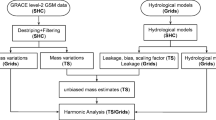Abstract
Gravimetric geoid undulations have been computed by the modified Molodensky truncation method (the Meissl procedure) and by the method of least squares spectral combination by optimal kernels (the Wenzel procedure). These undulations have been compared in two manners. One comparison used Doppler-derived undulation-at 65 stations in the United States as references. A second comparison used Geos-3 derived undulations in 30°×30° areas in the Indian Ocean and Tonga Trench as references. the mean difference of undulation-computed by the Wenzel procedure was 0.6 m smaller than that of the Meissl procedure when compared to the Doppler derived undulations. The standard deviations of the differences of both procedures appeared to be not significantly different. There are no significant changes in the mean differences of both procedures when compared to Geos-3 derived undulations. The standard deviations of the differences computed by the Wenzel procedure were of the order of 0.2 m smaller than those computed by the Meissl procedure.
Similar content being viewed by others
REFERENCES
J.Y. CRUZ: Ph. D. thesis in preparation. The Ohio State University, Comumbus, Ohio, 1984.
W. HEISKANEN and H. MORITZ: Physical Geodesy. W.H. Freeman and Co., San Francisco, 1967.
L. HOTHEM, T. VINCENTY and R. MOOSE: Relationship between Doppler and Other Advanced Geodetic System Measurements Based on Global Data, Proceeding of Int’l Geodetic Symposium on Satellite Doppler Positioning, Las Cruces, 1982.
International Association of Geodesy: Publication Spéciale du Bulletin Géodésique, Geodetic Reference System 1967, Paris, 1971.
C. JEKELI: Reducing the Error of Geoid Undulation Computations by Modifying Stokes’ function. Department of Geodetic Science, Report No. 301, The Ohio State University, Columbus, Ohio, May 1980.
G. LACHAPELLE: Comparison of Doppler-Derived and Gravimetric Geoid Undulations in North America, Proceeding of Int’l Geodetic Symposium on Satellite Doppler Positioning, Austin, Texas, January 1979.
G. LACHAPELLE and J. KOUBA: Relationship between Terrestrial and Satellite Doppler Systems, in Reference Coordinate Systems for Earth Dynamics. Gaposchkin and Kolaczek, ed., Reidel Pub. Co., Holland, 1981.
F. LERCH, S. KLOSKO, R. LAUBSCHER and C. WAGNER: Gravity Model Improvement Using Geos-3 (GEM9 and GEM10). Journal of Geophysical Res., Vol. 84, pp. 3897–3916, 1979.
H. MORITZ: Advanced Physical Geodesy. Abacus Press, Tunbridge Wells, Kent, U.K., 1980.
R.H. RAPP: “Accuracy of Potential Coefficients Obtained from Present and Future Gravity Data”. American Geophysical Union, Geophysical Monograph Series, Vol. 15, Washington, D.C., 1972.
R.H. RAPP: “A Global 1° × 1° Anomaly Field Combining Satellite, Geos-3, Altimeter and Terrestrial Data”. Dept. of Geodetic Science, Report No. 278, The Ohio State University, Columbus, Ohio, 1978.
R.H. RAPP: “Global Anomaly and Undulation Recovery Using Geos-3 Altimeter Data”. Department of Geodetic Science, Report No. 285, The Ohio State University, Columbus, Ohio, 1979.
R.H. RAPP: “A Comparison of Altimeter and Gravimetric Geoids in the Tonga Trench and Indian Ocean Areas”. Bull. Geod. No. 54, pp. 149–163, 1980.
R.H. RAPP: “Ellipsoidal Corrections for Geoid Undulation Computations”. Dept. of Geodetic Science, Report No. 308, The Ohio State University, Columbus, Ohio, March 1981 a.
R.H. RAPP: “The Earth’s Gravity Field to Degree and Order 180 Using Seasat Altimeter Data, Terrestrial Gravity Data, and Other Data”. Dept. of Geodetic Science and Surveying, Report No. 322, The Ohio State University, Columbus, Ohio], December 1981
R.H. RAPP: “A Summary of the Results from the OSU Analysis of Seasat Altimeter Data”. Dept. of Geodetic Science and Surveying, Report No. 335, The Ohio State University, Columbus, Ohio, 1982.
R.H. RAPP and R. RUMMEL: “Methods for the Computation of Detailed Geoids and their Accuracy”. Dept. of Geodetic Science, Report No. 233, The Ohio State University, Columbus, 1975.
R.H. RAPP and C. WICHIENCHAROEN: “A Comparison of Doppler Implied and Gravimetric Geoid Undulations Considering Terrain Corrected Gravity Data”. Journal of Geophysical Res., Vol. 89, B2, pp. 1105–1111, February 1984.
L. SJOBERG: “A Recurrence Relation for the βn-function”. Bull. Geod. No. 54, pp. 69–72, 1980.
G. WEBER and H.-G. WENZEL: “Error covariance Functions of Sea Gravity Data and Implications for Geoid Determination”. Paper presented at the General Meeting of the International Association of Geodesy, Tokyo, May 1982a.
G. WEBER and H.-G. WENZEL: “Estimation of Error Properties”, in Validation of Seasat—1 Altimetry Using Ground Truth in the North Sea Region, edited by Brennecke et al., Deutsche Geodätische Kommission Reihe B, Nr. 263, Frankfurt a.M., 19
H.-G. WENZEL: Zur Geoidbestimmung durch Kombination von Schwereanomalien und einem Kugelfunktionsmodell mit Hilfe yon Integral formeln. Zeitschrift für Verrnessungswesen, Vol. 106, no. 3, pp. 102–111, Stuttgart, 1961.
H.-G. WENZEL: “Geoid Computation by Least Squares Spectral Combination Using Integral Kernels”. Paper presented at the General Meeting of the International Association of Geodesy, Tokyo, May 1982a.
H.-G. WENZEL: “Least Squares Spectral Combination by Optimal Integral Kernels”, in Validation of Seasat—1 Altimetry Using Ground Truth in the North Sea Region, edited by Brennecke et el., Deutsche Geodätische Kommission, Reihe B, Nr. 263, Frankfurt a.M., 1982 b.
H.-G. WENZEL: “Computation for the Gravimetric Geoid GGNS3”, in Validation of Seatat—1 Altimetry Using Ground Truth in the North Sea Region, edited by Brennecke et al., Deutsche Geodätische Kommission, Reihe B, Nr. 263, Frankfurt a.M., 1982c.
Author information
Authors and Affiliations
Rights and permissions
About this article
Cite this article
Wichiengaroen, C. A comparison of gravimetric undulations computed by the modified Molodensky truncation method and the method of least squares spectral combination by optimal integral kernels. Bull. Geodesique 58, 494–509 (1984). https://doi.org/10.1007/BF02523696
Received:
Accepted:
Published:
Issue Date:
DOI: https://doi.org/10.1007/BF02523696




